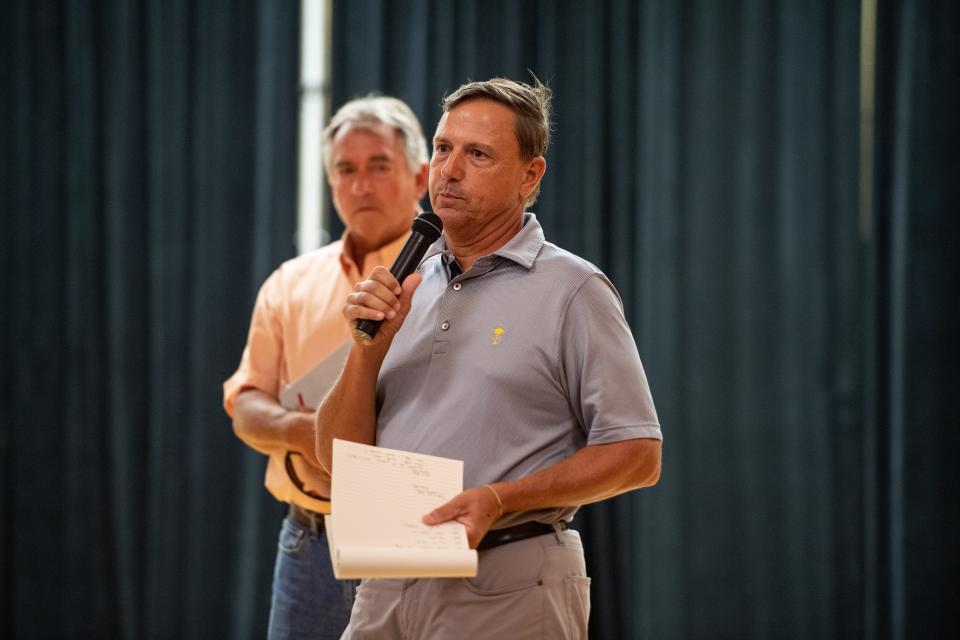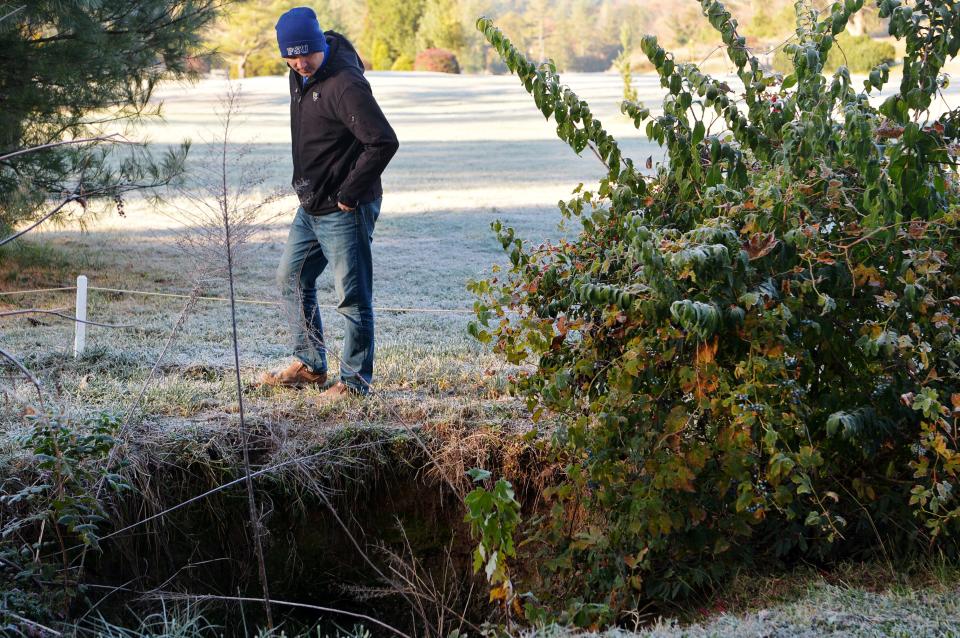157 trees recommended for removal at Asheville Municipal Golf Course
ASHEVILLE - A city evaluation recommends the removal of 157 oak, cherry and pine trees at the historic Asheville Municipal Golf Course, an action staff says is necessary for essential renovations to the course, improvements to golf play and longevity of existing trees.
While Chris Corl, the city's director of Community and Regional Entertainment Facilities, said this estimate is a low number compared to its initial U.S. Golf Association tree evaluation and report, which suggested 500-plus trees for removal, some members of the Urban Forestry Commission, area residents and environmentalists urge the city to reject the plan and call for further review.
Previous coverage:
Tree removal plan at Asheville's Muni Golf Course raises fears; city answers
Asheville sues former Muni Golf operator over course 'deterioration,' $340K in unpaid fees
Higher rates? Fairway improvements? Public meets new Asheville Muni Golf Course operators
Asheville Muni Course: Possible suit over $325K in unpaid fees? Pope Golf responds

At its Dec. 6 meeting, the Urban Forestry Commission approved a series of four recommendations to be sent to Asheville City Council, Corl's department and course manager Commonwealth Gold Partners - II Asheville LLC.
Three people spoke during public comment to advocate for saving the trees, questioning both the report and viability of the removal plan, and the commission received around 80 written comments, many with similar messages, said Chair Amy Smith.
Among those to speak was Nancy Casey, who has helped rally support around the course's trees, including the creation of a Facebook page, and said while she is in support of restoring "our beloved Muni golf course," she was also hopeful that the city could come up with a "a revised tree plan that emphasizes tree trimming over tree cutting, and better reflects our community values on saving mature trees."
More: Asheville's 1st trans school board member resigns following anti-LGBTQ attacks
Recommendations made by the commission included calls for a certified arborist, independent of the project, to do another review of all trees slated for removal using an industry tree risk assessment standard; a specific and detailed replanting plan, including species and abundance; information on soil testing, use of herbicides and other chemicals; and further exploration of alternates to removal, including pruning and other practices.
The motion passed unanimously among the six members present.
Though any future tree removal does not necessarily require City Council approval, Corl said if council decided to add the issue to an upcoming agenda and change the scope, or pump the brakes, they could.
The Urban Forestry Commission does not have the power to reject the project, but they can offer recommendations and insight.
Reparations: Commission requests Buncombe, Asheville audit to stop harm of Black residents
More: Buncombe's first equity officer exits after 1 year; Edens' roles included reparations
Tree removal, thinning and replacement are part of short- and long-term plans for the sprawling 122-acre course in the East Asheville neighborhood of Beverly Hills. Shading, water access and drainage are all affected by trees.
Corl said the project intends no net loss of total long-term tree canopy, and will replant, both on and off property, to meet city ordinance requirements.
Looking at the recommendations, Corl anticipated they would address them as soon as possible.
“As long as it’s not something that’s going to financially kill the project, and cost an exorbitant amount of money, there’s no reason that we wouldn’t follow all of these requests and recommendations," Corl told the Citizen Times following the Dec. 6 meeting.
The public, city-owned course has recently changed hands, under new management by Commonwealth Golf, which took over the course on Oct. 1 in a seven-year license and management agreement with the city.
More: Haywood Road resurfacing: What's coming to West Asheville's central corridor? Bike lanes?
More: What will replace Vance Monument? Public weighs in on Pack Square Plaza visioning project

The 18-hole golf course was designed by Hall of Fame golf architect Donald Ross and opened for play in 1927. It is home to the longest running professional tournament in the country owned and operated by Black people.
After the property's 10 years under former operator Pope Golf, the city alleges deteriorating course conditions which have allowed the greens, fairways and tees to fall into neglect. Notable among the concerns are the trees that line the course, many overgrown and overhanging the property, roots breaching the greens and the cart paths, stunting grass growth and shielding golfer sightlines.
Pope Golf is the subject of an ongoing lawsuit from the city, alleging $340,830 in outstanding lease payments.
Corl said efforts to remove trees to improve conditions of the course are nothing new, this is just the first time there has been available funding. He said many of the areas they are targeting have been bad for decades, even when run by the city and county, before Pope Golf.
More: Asheville ABC profits means millions in revenues for city, county. But who gets what?
The city has budgeted $250,000 for tree removal, thinning, and replacement in its tentative capital improvement plan.
“It’s the opportunity to really do something that the city, county and private operator in the past have all wanted to do, tried to do, and been unsuccessful in doing," Corl said. "That could make a really big boost for that neighborhood and that golf course, long term.”
Which trees are subject to removal?
The evaluation, and resulting statistics, was a culmination of several different evaluations, beginning with the $3,500 USGA Tree Evaluation, then a review with a golf architect to tag priority trees and, finally, evaluations with Tree Risk Assessment Qualification certified arborists, both Mark Foster, with the city, and a private arborist.
The evaluation resulted in a recommendation to remove 157 of the 2,387 trees on the property at "over six inches of diameter and breast height." It would result in the removal of about 1.2 non-invasive trees per acres, with the property averaging 20-plus trees an acre, and removal represents 6.58% of total trees on the property.
More: Asheville families experiencing homelessness? More winter shelter options on the way

Ten of the trees recommended for removal are invasive. Six are recommended solely to improve golf play, and are otherwise perfectly healthy, while the rest, according to Corl, are either unhealthy or "hazardous," a qualification that was the root of many of the meeting's arguments.
Of the trees to potentially be removed, the majority are white oak or white pine, with numerous cherry, red oak and shortleaf pine also considered, among others.
The plan also provides protections for trees with hawk nests, and Corl said they will not disturb them or others within a 25-foot radius.
He estimated the earliest trees would be removed is February and March.
Commission member Ed Macie expressed concern about how the risk assessment was conducted, and questioned if trees marked as a hazard, dying, or leaning could have issues resolved by options other than removal. He said the report was full of "generalities."
“These are a lot of trees that are being removed, and I’m not sold on the fact that many trees could present that severe a risk that they have to be removed without other practices that could mitigate that risk,” Macie said.
City arborist Foster, who had been among the evaluators, said it was “evident that the trees in questions could benefit the site and the people using the site by not being there."
“If you want to keep all of the trees, than you can certainly have a non-functional, non-money making golf course that looks really rough," Foster said. "I don’t understand the point of having a city facility that doesn’t perform its function.”
Commission member Patrick Gilbert backed up some of Macie's points.
"I would agree that we need to have a more technical assessment of the trees that are slated for removal," he said.
Sarah Honosky is the city government reporter for the Asheville Citizen Times, part of the USA TODAY Network. News Tips? Email shonosky@citizentimes.com or message on Twitter at @slhonosky.
This article originally appeared on Asheville Citizen Times: Asheville plans to remove 157 trees from Municipal Golf Course

